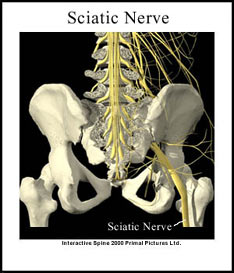In order to understand this topic it is important to understand the basic anatomy of the spine. Please review the section on basic spine anatomy before reading this section. To understand how the spine works, please review the section on the basic spine biomechanics.

www.scientificanimations.com/, CC BY-SA 4.0 https://creativecommons.org/licenses/by-sa/4.0, via Wikimedia Commons
What is sciatica?
Sciatica is the term used to describe pain in the lower back and hip that spreads down the back of the thigh and into the lower leg. It usually occurs as a result of pressure on a spinal nerve from a disc herniation or spinal stenosis.
What is the sciatic nerve?
The sciatic nerve is actually a bundle of many spinal nerves. The sciatic nerve is one of the longest nerves in the body and runs from the low back, through the buttocks and down the back of the leg. Branches of the sciatic nerve run down into the foot. Pressure on a spinal nerve can send a pain message down the sciatic nerve into the area supplied by the spinal nerve. The intensity of the pain can range from mild to excruciating.

What are the causes of sciatica?
Sciatica is a term used to describe the location of the pain but not its cause. Numerous different structures in the back and the leg can cause pain to spread down the back of the thigh and into the lower leg.
In most cases, the term “sciatica” is used to describe the symptoms that occur as a result of pressure on a spinal nerve from either a disc herniation or from narrowing of the boney space that the spinal nerve exits (spinal stenosis). In rare cases, infections in the intervertebral disc or tumors in the bone or surrounding soft tissues can cause sciatica. These relatively uncommon causes of sciatica are beyond the scope of this article.
Pain that spreads down the back of the thigh and into the lower leg can originate from injury to spinal joints, ligaments, or muscles. When these structures cause symptoms in the legs, it is usually described as “referred pain” rather than true sciatica.
How is the diagnosis of sciatica from a disc herniation made?
The first step in the diagnosis of a herniated disc is to obtain a good medical history and perform a physical examination. X-rays of the lower back may help rule out degenerative disc disease, spinal stenosis or other bone problems of the spine. An MRI is a very good test to determine if there is a disc herniation. The MRI can detect if there is pressure from the disc herniation on one of the spinal nerves. A CT scan (CAT scan) may also be helpful because it is better than an MRI at looking at the bones in the spine as a cause of pressure on the spinal nerves.
What other information is available on disc herniations and sciatica?
Visit Back Pain Info / Neck Pain Info’s section on disc herniations for more information on this topic. Back Pain Info / Neck Pain Info’s links section has additional information on disc herniations and sciatica. Links have been provided to other websites as well as online medical journals. Visit Joint Pain Info. Com for information on other joint injuries and problems.
